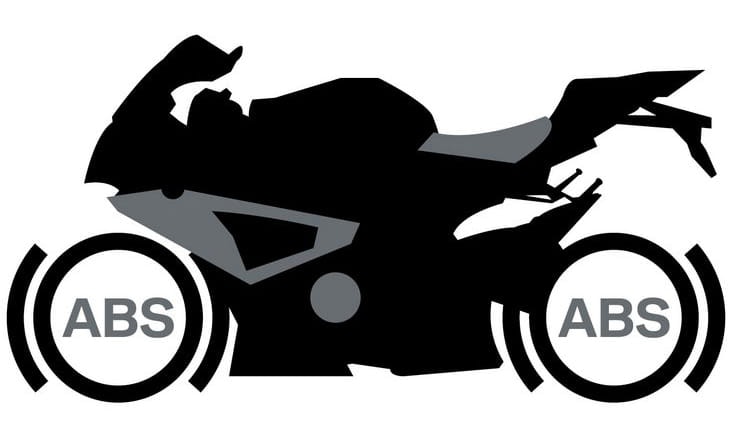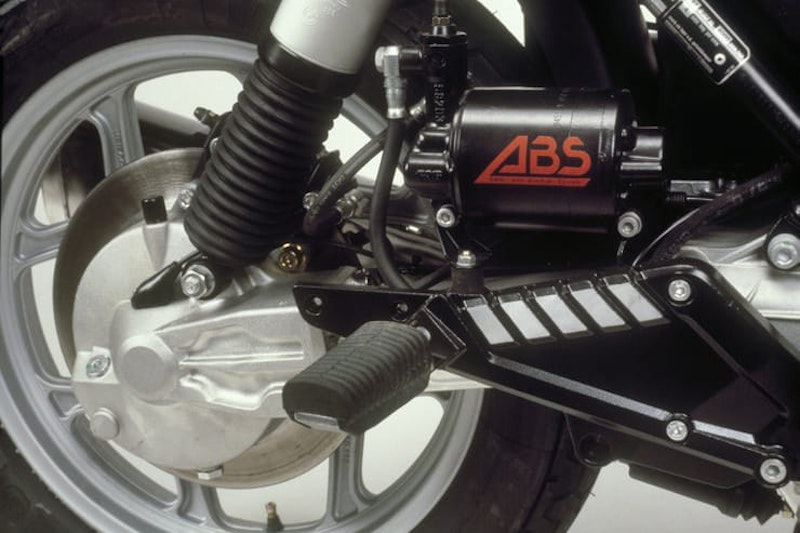ABS braking systems designed specifically for motorcycles have been around for over 25 years now, in fact the first anti-lock braking system for motorcycles came onto the market in 1988. The first ones were variations of the car systems which had appeared some ten years earlier and were quite large and weighty items weighing as much as 11kg.
The braking characteristics of a two-wheeled vehicle with independent braking systems are of course completely different to those of a four-wheeled vehicle with all the brakes being linked together and operated through one pedal. Eventually, systems became motorcycle specific and the weight has now dropped below 1kg in weight and for 2016 it will be compulsory for all bikes over 125cc to be fitted with an ABS system.
One of the pioneers in braking technology was Bosch whose units were offered as an optional extra on BMW’s K 100 series in 1988. These early units still worked on hydraulics with moving pistons and it was Honda that introduced the first electro-hydraulic units on the ST100’s in 1992
Since then things have moved on rapidly as technology has evolved with Bosch still being at the forefront of things, hence their latest system which is now capable of supporting the rider during both braking and accelerating, both while upright, but now while cornering.
Called the Motorcycle Stability Control System or MSC, it is a combination of ABS and a Traction Control system (TCS) all working toward preventing the rider losing control, especially on bends while braking or accelerating.
The new system uses an extensive array of sensors to register the various riding dynamics of the machine. Traditional wheel sensors measure the rotational speed of the front and rear wheels, while an inertia sensor module computes the vehicles lean and pitch angles at more than 100 times per second.
The information from the various sensors is compared to stored data on things such as tyres sizes and then the ABS control unit calculates the physical limits of brake force on the basis of lean angle. From then on, if it recognises that a wheel is starting to lock, the ABS control unit activates the pressure modulator in the hydraulic brake circuit in the normal manner releasing and applying the brakes as required.
But, while the ABS unit may be the basis of the new system, Bosch claim it has many other benefits and helps with handling and cornering, the latter being the biggest cause of motorcycle crashes and fatalities. In 2010, more than 5,000 motorcyclists died in road accidents in Europe alone. Studies show that ABS on its own can prevent around one-quarter of all motorcycle accidents that lead to injury or death.
"Almost one in two fatal motorcycle accidents occurs in a bend," says Gerhard Steiger, president of the Bosch Chassis Systems Control division. "The Bosch MSC motorcycle stability control can help further reduce the number of accidents."
How it does this is quite complex and it is the various new sensors linked into the system and the programming that help improve stability in all situations. Braking in bend will normally result in rider and machine parting company, but this new system will help alleviate that problem and help reduce the ‘lowside’ crash.
These are accidents in which the motorcycle falls during cornering and the wheels slide out toward the outside of the bend. They occur when too much brake force is applied during cornering and the wheels are not able to transfer sufficient side force onto the road.
MSC counteracts this by detecting the risk of a lowside and limiting the maximum brake force. The eCBS function distributes this maximum available brake force between the wheels, ensuring the best possible brake performance under cornering conditions.
Also, as most riders know that if you brake hard mid –corner, the bike tends to sit upright and try and go straight on, or it takes a larger cornering radius, in both cases leading to a potential crash.
Bosch claim the MSC reduces the motorcycle's tendency to return to an upright position thanks to the eCBS electronic combined brake system deciding on the best possible distribution of brake force between the wheels, and therefore stabilising the bike during cornering. The same function ensures optimum distribution of brake force even only one of brakes is used, or too much force is applied to a lever.
Also helping stability is the rear-wheel lift-up mitigation function that keeps the rear wheel on the road by reducing the maximum brake force on the front wheel when riding on surfaces with high friction coefficients. Riding stability is maintained, taking pitch rate and longitudinal acceleration into account.
Likewise, at the front end, the wheelie-mitigation (anti-wheelie system) controls the engine torque, preventing the front wheel from lifting uncontrollably and at the same time ensuring maximum acceleration while TCS stops the rear end spinning up.
Despite the obvious benefits and safety features of this new system Bosch are at pains to point out that it cannot suspend the laws of physics. So if a rider does not continue to ride appropriately for the conditions and gets things too badly out of shape, they will still crash and this system will only help save things in a borderline situation.
The system has already been adopted by KTM and they claim it will be available at the end of 2013 on the KTM 1190 Adventure and 1190 Adventure R 2014 models with no doubt other manufacturers following suit in the near future.
ABS and Traction Control explained in simple terms
Traction control and ABS explained
Rider Aids - traction control and ABS explained

